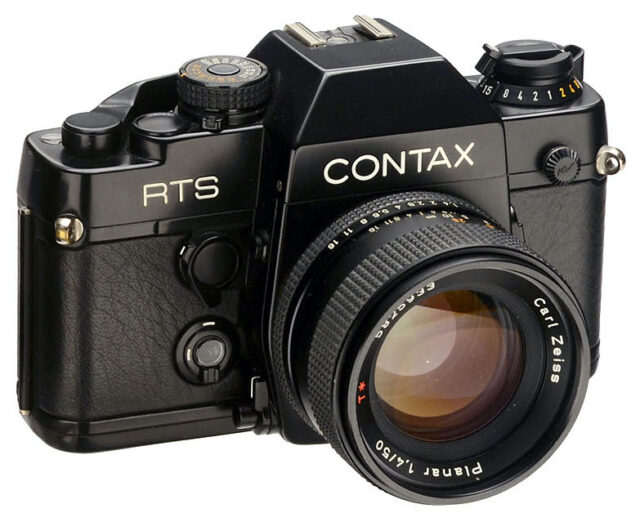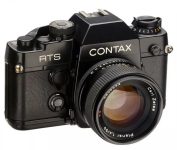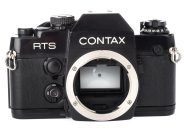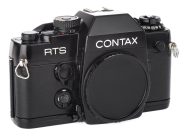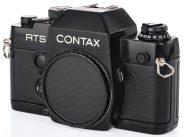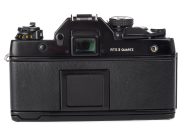Announced
Production status
System
Contax/Yashica system cameras
- Contax 137 MA Quartz
- Contax 137 MD Quartz
- Contax 139 Quartz
- Contax 159 MM
- Contax 167 MT
- Contax Aria
- Contax AX
- Contax Preview
- Contax RTS
- Contax RTS II Quartz
- Contax RTS III
- Contax RX
- Contax RX II
- Contax S2
- Contax S2b
- Contax ST
- Yashica 107 Multi Program
- Yashica 108 Multi Program
- Yashica 109 Multi Program
- Yashica FR
- Yashica FR I
- Yashica FR II
- Yashica FX-1
- Yashica FX-103 Program
- Yashica FX-2
- Yashica FX-3
- Yashica FX-3 Super
- Yashica FX-3 Super 2000
- Yashica FX-70 Quartz
- Yashica FX-D Quartz
Contax RTS II Quartz
35mm MF film SLR camera • Discontinued
Specification
| Format: | |
| 35mm full frame | |
Film type: | 135 cartridge-loaded film |
| Contax/Yashica [45.5mm] | |
| Shutter: | |
Type: | Focal-plane |
Model: | Electronically controlled |
Speeds: | 16 - 1/2000 + B |
| Exposure: | |
Exposure metering: | Through-the-lens (TTL), open-aperture |
Exposure modes: | Aperture-priority Auto |
| Manual | |
| Physical characteristics: | |
Weight: | 735g |
Dimensions: | 142x89.5x50mm |
Manufacturer description #1
Type: 35 mm single-lens reflex featuring electronically controlled AUTO/manual exposure, focal plane shutter.
Image size: 24 x 36 mm.
Lens mount: Contax/Yashica mount.
Standard lenses: Carl Zeiss Planar T* 50 mm f/1.4, Carl Zeiss Planar T* 50 mm f/1.7
Shutter: Quartz-timed, electronically operated horizontal-travel titanium focal-plane shutter.
Shutter Speed: AUTO mode.... 1/2000 to 16 sec. Manual mode.... 16 settings of X (1/60 sec.), 1/2000 to 4 sec., and "B"; and when out of battery, mechanical shutter with settings of 1/50 sec. and "B"
Synch Terminals: X Contact (synch speed 1/60 sec.), direct X contact, and synch terminal.
Self-Timer: Quartz-timed electronic self-timer with 10 sec. delay. LED flashes during operation, accelerating 2 sec. before shutter release. Can be cancelled during countdown.
Shutter Release: Real Time Electromagnetic Release System; auxiliary remote release via "Release Socket".
Exposure Modes: Aperture priority automatic exposure; and manual exposure
Exposure Control: Through-the-lens (TTL) center-weighted metering at full aperture using SPD (Silicon Photo Diode) cell. EV range from EV -1 (f/1.4 at 4 sec.) to 19 (f/16 at 1/2000 sec.) at ASA 100 with f/1.4 lens. ASA range from 12 to 3200.
Auto Flash Control: Direct TTL metering automatically coupling with Contax TLA Auto Flash system via an SPD sensor. Synch speed: Shutter speed automatically set to 1/60 sec. upon completion of recycling.
Exposure Check Button: Pressing button activates LED display for 16 sec.
Exposure Compensation: +2 EV ~ -2 EV via exposure compensation dial (click stops at every 1/2 EV; can be set for in-between-click stops).
AE Lock: Lever type (locks in exposure value metered at image plane)
Viewfinder: Eye-level pentaprism type • Field shows 97% of picture area; Magnification ratio 0.87X (50 mm standard lens) • Viewfinder eyepiece-blind: lever operated
Focusing Screens: Microprism focusing screen comes as standard equipment. Seven other interchangeable type screens are available
Viewfinder Display: Aperture display, exposure compensation display (LED digital display - red), shutter display; over- or under-exposure display (alphanumerical LED array - red), TLA flash unit flash ready/after flash signal mark (LED display - green).
Film Advance: With full stroke of 120 degree setting angle and 20 degree standoff position; or several short strokes. Features film feed indicator, and automatic winding capability when used with motor drive or winder system
Film Rewind: Film rewind crank-handle with clutch action, and film rewind release button with automatic resetting
Exposure Counter: Automatically resetting type. Until counter registers "1", camera will automatically set at shutter speed of 1/60 sec. regardless of the setting adjustment on the shutter control dial (except "B" setting).
Multiple Exposures: Enabled by depressing film rewind release button
Accessory Shoe: Direct X contact, and accepts TLA Auto Flash system units.
Camera back: Opens by pulling film rewind knob all the way out. Provided with memo holder. Camera back removable.
Depth-of-Preview Button: Button type that doubles as mechanical shutter release button
Mirror Lock: Lever operated
Power Source: 6.2 V silver-oxide battery (Eveready 544, Ucar 544, Mallory PX28 or equivalent), or 6 V alkaline-manganese battery (4LR44 or equivalent). Provided with a main switch
Battery check: Indicated via steady or pulsating light pattern of LED display in the viewfinder
Other Features: Provided with couplings for motor drive and winder, and with LED for Data Back application.
Manufacturer description #2
The new CONTAX RTS II Quartz represents a quantum leap in Real Time Photography, combining all of the advantages of the original RTS camera with advanced new mechanical and electronics technology to produce a 35mm SLR more accurate, more consistent and more reliable than any other camera in the world.
Most of the improvements in the RTS II Quartz are internal, reflecting more advanced electronics and more reliable mechanical functions. The camera body itself retains the smooth, sleek Porsche design of the RTS, with a few new control points for its enhanced photographic capabilities.
Among the innovations found in the RTS II Quartz are: Quartz Crystal Timing of shutter speeds and all time-related camera functions; Dual SPD exposure metering for full compatibility with the Contax TLA Auto Electronic Flash System, Improved Shutter with Titanium curtains and shaft bearings; Exposure Value-based AE Lock function; Increased Field-of-View to 97% of the total picture area, Digital Viewfinder LED Data Display; Mechanical Shutter Release options at 1/50 sec. and B.
And these new features back up the outstanding Real Time operations retained from the original RTS body, including AE/Manual Mode exposure metering, 1/2000 sec. top shutter speed, Electromagnetic shutter release, Contax/Yashica 3-claw bayonet mount for Carl Zeiss T* lenses and complete integration of all system accessories.
Naturally, all standard Real Time System accessories can be employed with the RTS II Quartz. Improved versions of the Professional Motor Drive (W-6 model) and Real Time Winder (W-3 model) have been specially developed [although previous PMD/RTW units may be used]. A new Quartz Data Back D-4 with remarkably expanded capabilities is available for the RTS II Quartz, along with an upgraded External Power Pack P-3 that offers considerably expanded power capacity. A special new series of interchangeable focusing screens (FS-type) has been introduced in conjunction with the increased 97% field-of view.
MAIN FEATURES:
Quartz Crystal Timing - The RTS II Quartz now features the same advanced Quartz timing perfected in the Contax 137 MD Quartz and 139 Quartz cameras, assuring exceptional accuracy and total consistency of shutter speeds and all time-related camera functions. The Quartz Crystal Element pulses at a rate of 32,768/second to offer shutter speeds immeasurably more accurate and consistent than any previous mechanical or electronic timing system. The Quartz element also regulates the timing of various operations within the camera body, to improve reliability, durability and consistency of operation.
Dual SPD Exposure Metering - Two Silicon Photo Diode (SPD) cells within the camera body provide instantaneous reaction to even the slightest variation in lighting. One SPD is employed for ambient light exposure measurement, the other for Contax TLA flash exposure control. The SPDs measure center-weighted light patterns, at maximum aperture, for optimum exposure accuracy.
Central Processing Unit - The heart of the RTS II Quartz is a sophisticated C-MOS LSI microprocessing 'chip' which, together with the Quartz Element, comprises the camera's Central Processing Unit. This CPU accepts exposure information in digital values (converted from analog by a Bi-MOS Integrated Circuit) and relays commands to the camera's operating circuitry. The data processing capabilities of this CPU would have required entire rooms of computer equipment just one generation ago; today they are fully integrated on a single flexible circuit board fitting inside the camera body.
AE/Manual Mode Exposure Control - Both AE and Manual operating modes are available with the RTS II Quartz. In the AE Mode, the camera's CPU determines shutter speed automatically, according to the other exposure factors. In the Manual Mode, the camera "recommends" a shutter speed for optimal exposure to the photographer. [AE Mode shutter speeds are stepless within a range of 16 to 1/2000 sec.; Manual Mode shutter speeds range from 4 to 1/2000 sec., and include "B" and "X" (1/60 sec.) settings.]
TLA Auto Flash Compatibility - The RTS II Quartz offers complete compatibility with The Contax TLA flash system, including direct TTL metering of flash exposures at the film plane and 'Fail-Safe' automated control of flash/shutter synchronization. Flash output is metered by an SPD cell, and monitored by the CPU which signals cutoff of the flash when perfect exposure has been achieved. The camera automatically switches between proper X-synch shutter speeds and ambient lighting shutter speeds, depending on the readiness of the TLA unit to fire. AE Lock or Manual Mode use allows setting of shutter speeds slower than the standard 1/60 sec. speed used for X-synch.
Viewfinder LED Data Display - An improved, digital LED data display in the RTS II Quartz viewfinder provides the photographer with full information on Shutter Speeds, Aperture, AE/Manual Mode operation, AE Lock use, Exposure Compensation use, TLA Flash 'Ready' indication, Accurate TLA Flash Exposure, OVER Exposure warning and Battery Check. The LED Display is turned on by pressing the Exposure Check Button on the front of the camera body. After 16 seconds the display cuts off, to conserve battery power, and can be activated again simply by pressing the button once more.
AE Mode shutter speeds are indicated by a steadily-lit LED. Use of the camera's exposure metering system in Manual Mode requires alignment of two LEDs, one steadily lit at the recommended shutter speed, the other flashing at the set shutter speed. Alignment is possible by adjusting either shutter speed or aperture settings.
AE Lock use in AE Mode is indicated by a flashing, rather than steadily-lit shutter speed LED.
In TL A Mode (automatic when TLA unit is attached to camera), a steadily-lit green arrow LED indicates the flash unit is prepared to fire. This LED also operates as a 'confidence light', flickering after a flash exposure if the exposure was correct. [Note: possible over-exposure of scene is indicated by "OVER" LED in all modes.)
Exposure Compensation use is indicated by red +/- LEDs at the bottom of the frame, next to the aperture LED.
Automatic Battery Check is provided by the data display. If the display flickers at slow intervals when turned on, batteries should be replaced.
The viewfinder LED data display also features a special two-stage control which automatically brightens or dims the LED indicators, according to ambient lighting.
AE Lock Function - The AE Lock function of the RTS II Quartz is of a wholly new type, based on Exposure Value factors. Rather than freezing the exposure system at a particular shutter speed, the RTS II Quartz freezes in an Exposure Value, so that any adjustment of aperture will result in automatic adjustment of shutter speed to maintain consistent exposure. This new system is particularly advantageous in providing for photo series, in which exposure is consistent while depth-of-field varies.
Exposure Compensation Function: In order to allow the photographer to vary exposure for creative effect, the RTS II Quartz incorporates an Exposure Compensation Function providing for ±2EV exposure variance, with intermediate click-stops. The main uses of this function are in overcoming moderate back or side-lighting, or as a means of bracketing exposures under difficult lighting conditions.
Improved Shutter - The RTS II Quartz features an entirely new shutter mechanism, with Titanium curtains for improved high-speed accuracy and consistency and increased durability. Only half the weight of standard cloth shutter curtains, these Titanium curtains offer extreme resistance to heat and cold. Six shutter shaft bearings guarantee smoother operation with reduced friction, while a special declutching mechanism frees the shutter itself from the film wind mechanism after cocking, to lighten the running load and eliminate inertial drag. A wedge-shaped shutter brake is highly effective in damping shock, contributing to reduced wear and increased consistency.
Electromagnetic Release - Naturally the RTS II Quartz features the standard Contax electromagnetic shutter release, with its feather-touch 0.7mm stroke and full system compatibility for electronic accessories. In the RTS II Quartz, however, this is backed up by two optional manual mechanical release capabilities. To use the camera at a mechanical 1/50 sec. shutter speed, the photographer turns the Mechanical Shutter Switch Lever to the horizontal position. This turns the Depth-of-Field Preview Button into a mechanical shutter release button for 1/50 sec. operation. The camera can also be used at a mechanical B (Bulb) setting by threading a standard cable release into the mechanical release socket (lower right side of lens mount). This feature is useful in conserving battery power during extremely long exposures (astrophotography, etc.).
97% Field-of-View - In order to prevent the appearance of distracting, unwanted elements in the final image, the RTS II Quartz features a field-of-view increased to 97% of the picture area.
Contax/Yashica Bayonet Mount - The RTS II Quartz offers complete integration with all Carl Zeiss T* lenses and Contax Real Time System optical-path accessories through use of the standard three-claw bayonet lens mount. This rugged, durable stainless steel mount provides optimum linkage between the camera body and either lenses or accessories, and is designed to withstand even long years of hard, professional use.
Quartz Self-Timer - A Quartz-timed, 10-second delay Self-Timer is incorporated into the RTS II Quartz. The Self-Timer can be reset or cancelled at any time during operation, which is indicated by a flashing red LED on the front of the camera body (flashes accelerate during the final two seconds before shutter release).
Auto 1/60 sec. Wind-On - When new film is loaded in the camera and the camera back is closed, a shutter speed of 1/60 sec. is automatically set (AE or Manual Modes, except "B") until film wind to Frame 1 in the counter is reached. This is particularly convenient for the photographer who loads film in the shade, to prevent unduly long AE shutter speeds while winding on to Frame 1. Normal AE or Manual shutter speeds begin with Frame 1.
OTHER FEATURES:
Other special features of the Contax RTS II Quartz include: a built-in eyepiece shutter, shutter dial locks at A and X positions, a Main Switch controlling all electronic circuitry, a screw-in flash terminal and release socket, a flip-up key for the battery cap (rather than the standard coin-slot type) and a memo-holder on the back cover.
EXCLUSIVE ACCESSORIES:
Exclusive accessories for use with the RTS II Quartz include: External Power Pack P-3, Professional Motor Drive (W-6), Real Time Winder (W-3), FS-type Focusing Screens and Data Back Quartz D-4.
SYSTEM ACCESSORIES:
All Contax Real Time System accessories integrate fully with the RTS II Quartz camera, including Close-Up/Macro and Off-Camera Control Systems, TLA Auto Flash equipment and Carl Zeiss T* lenses.
